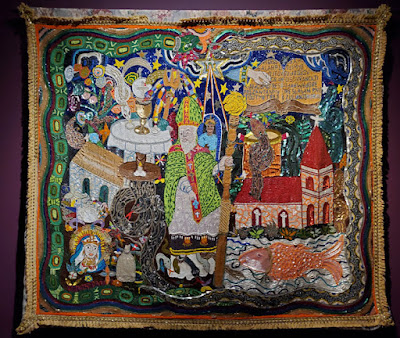 |
| Art of Myrlande Constant (detail), Fowler Museum, Los Angeles, CA |
Myrlande Constant is a Haitian textile artist whose works reflect the vibrancy of life in Haiti--from family celebrations to religious traditions. As you enter the gallery at the Fowler Museum atUCLA in Los Angeles where her works are currently exhibited, you are struck by the explosion of color. The tapestries literally shimmer on the walls.
 |
| Myrlande Constant: The Work of Radiance, gallery at the Fowler Museum |
Created with thousands of tiny beads that capture and reflect the light, it is almost impossible to convey their beauty and complexity in a still photo. Even a short video barely does them justice.
Constant's textile designs originate in the Haitian tradition of beaded flags, or drapo, and include images from Haitian daily life and from Constant’s ancestral religion, Vodou. But the beading technique introduced by Constant allows for greater detail and scale than traditional drapo Vodou, which typically use sequins. Constant's tiny beads, sewed on one by one, create a rich three-dimensional surface..
| The fighting cock is a symbol of Ogou, the warrior Iwa. |
In all Constant's works, her name becomes part of the design--with the "n's" sometimes inverted. Many are "framed" with elaborate borders.
 |
| Erzulie Dantor, 1995-2020. |
Constant spent 25 years working on her portrait of Erzulie Dantor. Erzulie Dantor is credited with launching the Haitian Revolution, which overthrew colonialism and abolished slavery, creating the first independent Black republic. She is revered as a symbol of Black working class motherhood.
 |
| Detail of Haiti, Tuesday, January 12, 2010. |
Political and current events are also the subject of some of Constant's pieces. In the year after the catastrophic 2010 earthquake, Constant created this tapestry, filled with scenes she had witnessed in her own community.
The above photos are just samples of the dozens of works on display in the Fowler Museum exhibit. In addition to the textiles on the walls, a video interview of Constant Myrlande in her studio plays in an adjacent room, providing insight on her method and purpose. The exhibit at the Fowler ends August 27, 2023. If you cannot see it in person, you can read about it in the book Myrlande Constant: The Work of Radiance, Katherine Smith and Jerry Philogene, editors (Fowler Museum UCLA, 2023). She is a remarkable woman. This is the first U.S. museum exhibition devoted to the work of a Haitian femaile contemporary artist.
 |
| Baron Vulgaire, Baron Ravage. |


































